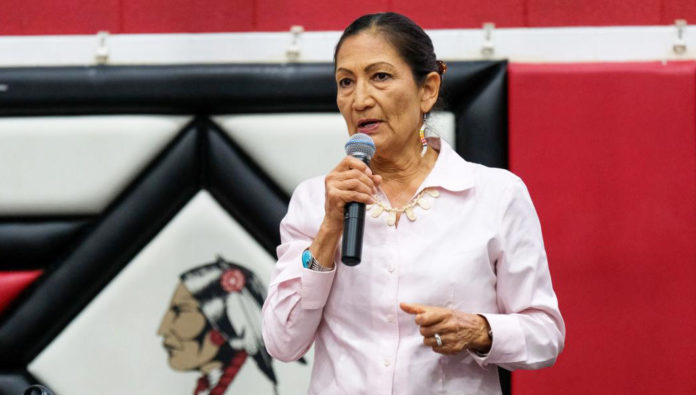WASHINGTON, D.C. – The Department of the Interior has announced next steps on the Federal Indian Boarding School Initiative, launched in June 2021 by Secretary Deb Haaland as the first-ever comprehensive effort by the federal government to recognize the troubled legacy of past federal Indian boarding school policies with the goal of addressing their intergenerational impact and shedding light on past and present trauma in Indigenous communities.
The Department released the second and final volume of the investigative report called for as part of the initiative, led by Assistant Secretary for Indian Affairs Bryan Newland. The second volume builds on the initial volume published in May 2022 to significantly expand on the number and details of institutions to include attendee deaths, the number of burial sites, participation of religious institutions and organizations, and federal dollars spent to operate these locations. It also includes policy recommendations for consideration by Congress and the Executive Branch to continue to chart a path to healing and redress for Indigenous communities.
“The federal government – facilitated by the Department I lead – took deliberate and strategic actions through federal Indian boarding school policies to isolate children from their families, deny them their identities, and steal from them the languages, cultures and connections that are foundational to Native people,” said Secretary Haaland. “These policies caused enduring trauma for Indigenous communities that the Biden-Harris administration is working tirelessly to repair. I am immensely proud of the hundreds of Interior employees – many of them Indigenous – who gave of their time and themselves to ensure that this investigation was thoroughly completed to provide an accurate and honest picture. The road to healing does not end with this report – it is just beginning.”
“For the first time in the history of the United States, the federal government is accounting for its role in operating historical Indian boarding schools that forcibly confined and attempted to assimilate Indigenous children,” said Assistant Secretary Newland. “This report further proves what Indigenous peoples across the country have known for generations – that federal policies were set out to break us, obtain our territories, and destroy our cultures and our lifeways. It is undeniable that those policies failed, and now, we must bring every resource to bear to strengthen what they could not destroy. It is critical that this work endures, and that federal, state and tribal governments build on the important work accomplished as part of the Initiative.”
Volume 2 updates the official list of federal Indian boarding schools and maps to include 417 institutions across 37 states or then-territories. It provides detailed profiles of each school and confirms that at least 973 American Indian, Alaska Native, and Native Hawaiian children died while attending federal operated or supported schools. It also identifies at least 74 marked and unmarked burial sites at 65 different school sites, and estimates that the U.S. government made appropriations available of more than $23.3 billion in fiscal year 2023 inflation-adjusted dollars between 1871 and 1969 for the federal Indian boarding school system as well as other similar institutions and associated assimilation policies.
In the process of publishing these two volumes, the Department’s staff and contractors reviewed approximately 103 million pages of federal records. Secretary Haaland and Assistant Secretary Newland also met with government officials and Indigenous leaders from Australia, Canada and New Zealand to understand the processes they used to address the legacy of similar assimilation policies, to include boarding schools and institutions.
The report includes eight recommendations for the federal government from Assistant Secretary Newland that aim to support a path to healing the nation, including:
- Issuing a formal acknowledgment and apology from the U.S. government regarding its role in adopting and implementing national federal Indian boarding school policies
- Investing in remedies to the present-day impacts of the federal Indian boarding school system
- Establishing a national memorial to acknowledge and commemorate the experiences of Indian tribes, individuals, and families affected by the federal Indian boarding school system
- Identifying and repatriating remains of children and funerary objects who never returned from federal Indian boarding schools
- Returning former federal Indian boarding school sites to tribes
- Telling the story of federal Indian boarding schools to the American people and global community
- Investing in further research regarding the present-day health and economic impacts of the federal Indian boarding school system
- Advancing international relationships in other countries with similar but their own unique histories of boarding schools or other assimilationist policies.
In recognition of the damage that federal Indian boarding schools and associated policies had on Native languages, investing in their restoration and preservation has been an early priority of the Biden-Harris administration. In 2021, the Departments of the Interior, Education and Health and Human Services launched an interagency initiative to preserve, protect and promote the rights and freedom of Native Americans to use, practice and develop Native languages. Since then, both Secretary Haaland and Assistant Secretary Newland have traveled with First Lady Jill Biden and other Administration leaders to learn more about how tribal nations are leveraging federal investments to revitalize Native languages. The Administration expects to roll out a new ten-year Native Language Strategy by the end of 2024.
Telling the story of the impact of these boarding schools has been a guiding purpose of the Federal Indian Boarding School Initiative, including Secretary Haaland’s op-ed sharing her own personal history. In late 2023, Secretary Haaland and Assistant Secretary Newland completed “The Road to Healing,” a historic 12-stop tour across the country that provided Indigenous survivors the opportunity to share with the federal government their experiences in federal Indian boarding schools for the first time. The Road to Healing events included opportunities to connect survivors with trauma-informed support through the Department of Health and Human Service’s Indian Health Service and Substance Abuse and Mental Health Services Administration. The reflections of many of those individuals are included in Volume 2 and transcripts are available on the Federal Boarding School Initiative website.
The Department also launched an oral history project to document and make accessible to the public the experiences of generations of Indigenous then-children who attended the federal Indian boarding school system. Through a grant from the Bureau of Indian Affairs and with funding from the Mellon Foundation and the National Endowment for the Humanities, the National Native American Boarding School Healing Coalition is currently interviewing survivors for what will be a collection of first-person narratives. The Department and the Smithsonian’s National Museum of American History, part of the largest museum, research and education complex in the world, are partnering to explore how best to share with the public the history of the federal Indian boarding school system and its role in U.S. development, with a proposed focus on the never-told-before experiences of survivors.
Some institutions classified as historical federal Indian boarding schools continue to operate in the United States, but without assimilationist intentions or practices, including schools operated or funded by the Bureau of Indian Education (BIE). The BIE provides high-quality educational opportunities from early childhood through life, accounting for the mental, physical, religious and cultural aspects of Native learners. Similarly, Kamehameha Schools across the Hawaiian Islands provide critical educational services, to include essential language preservation curriculum, that is unique and foundational to the Native Hawaiian community.














































